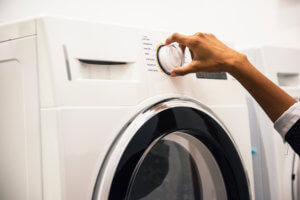
Do you ever wonder how people coped before household appliances? It boggles the mind – especially as domestic chores can be hard enough even with the help of our electrical peers.
Yet there’s nothing more cringe-inducing than the thought of these much-loved appliances – designed purely to clean – being infected with its own antithesis: Mold. Of the 100,000+ types of mold, over 1,000 are found in US homes. Eeek. We would say it doesn’t bear thinking about, if the removal of this fiendish fungi wasn’t so important. And seeing as so many appliances work with water (think washing machine, dishwasher and freezer), it’s a problem that arises time and time again, due to “poor venting and high level of moisture in the appliance, high level of humidity in the kitchen, darkness and supply of food”, according to professional cleaning technician at Fantastic Services, Dean Davies.
Fear not, good reader. MoldBlogger is, as ever, awash with the tips you – and your appliances – need to survive.
Washing machines
Front load
What? Trapped moisture when the door and/or drawers are closed causes mold to grow and hide inside the door seal and detergent drawer. Other bacteria, such as E. coli and salmonella, can also emerge from underwear or kitchen cloths.
How? Mix 2 cups white vinegar, ¼ cup baking soda and ¼ cup water and wipe affected areas.
Top Tip? Take laundry out as soon as the load finishes and leave both the door and drawer open when not in use. “Clean the rubber door gasket using hot soapy water and a rag”, Dean advises.
Top load
What? The combination of water and humidity after a load causes mold to make itself at home between the drum and interior walls.
How? Run the Clean Washer cycle once a month if your washer has one, otherwise, run a hot water cycle with 3 to 4 cups of vinegar (or bleach) to ½ cup baking soda. The baking soda “will help in removing the mold smell from the machine as well”, Dean explains.
Top Tip? Don’t use too much detergent and leave the lid open after each use.
Refrigerators
What? The combination of warm air, moisture, food and lack of ventilation causes mold to appear between the door seals – not to mention neglected food.
How? Before starting to clean the refrigerator, “unplug it and remove all the contents from it”, says Dean. “Check if any food packages are leaking or any food has expired and throw it out. Remove all the shelves and drawers and wash them in the sink using only a dishwashing detergent and water. If any removable parts have mold, soak them in a bathtub filled with warm water and 2 cups of white vinegar. Leave them to soak for about an hour, then rinse them with clean water and dry them with paper towels.
“Wipe all the interior surfaces of the fridge with a vinegar-soaked rag. To reach small corners and crevices use a soft bristle toothbrush, dipped in a bowl of vinegar. Rinse the entire refrigerator with clean water using a new rag. If you notice mold odor, wipe the fridge with a cleaning solution made of a ¼ cup of baking soda and 3 cups of warm water. Dry the appliance with clean paper towels and place the shelves and drawers back.”
Top Tip? An article on the Sears Home Services website advises cleaning spills immediately and wiping down with vinegar once a month. Distilled white vinegar also works wonders in coffee machines, FYI!
Dishwashers
What? Damp food particles left behind after a cycle can cause mold to infiltrate the filter, cutlery basket, interior panels and door gasket. Dishwashers are particularly susceptible to Exophiala (one study found that 62% contained the fungi!), can cause systemic disease in humans and colonize the lungs of those with cystic fibrosis.
How? Pick up debris from the drain before scrubbing the interior and gasket with diluted bleach.
Top Tip? Keep on top of mold by cleaning out the gasket and running an empty cycle – other than a cup of white vinegar on the top rack – regularly (at least once a month). Also check and clean the cutlery basket and filter regularly. Sprinkle a cup of baking soda on the bottom of the dishwasher from time to time, too.
Read more about keeping kitchens mold-free here.
from Mold Blogger https://moldblogger.com/mold-and-appliances/
Mold Remediation Baltimore
No comments:
Post a Comment